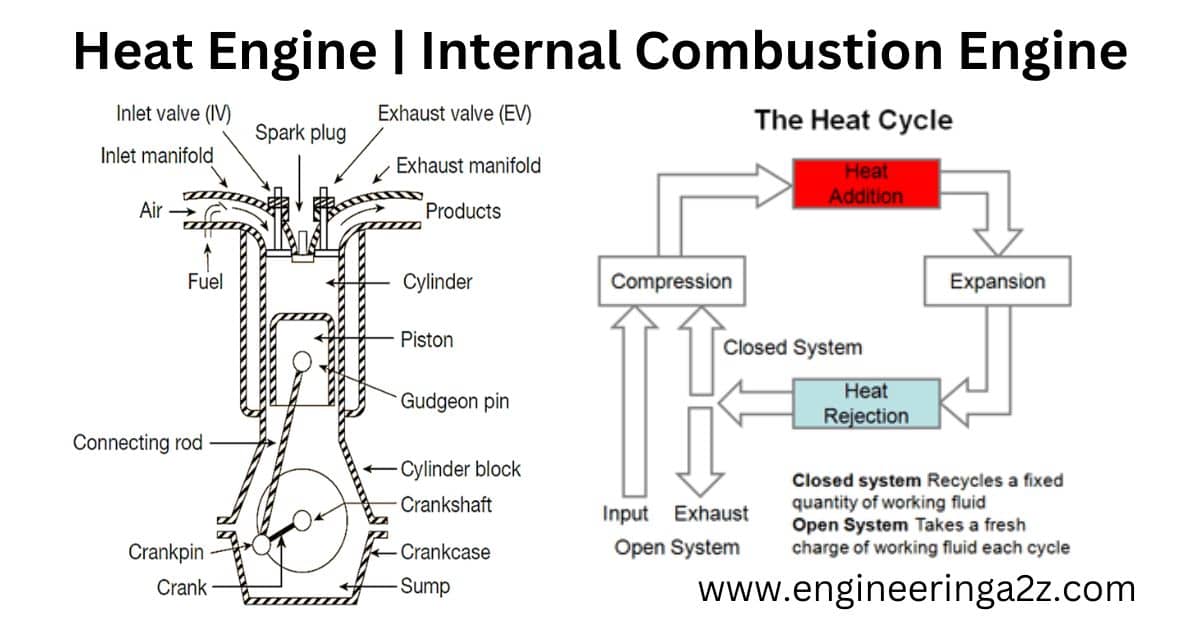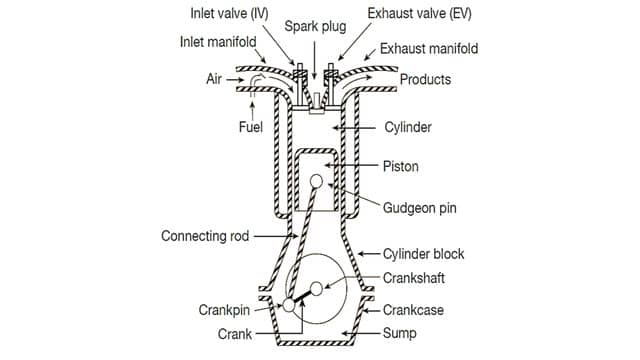
Table of Contents
Heat Engine
Heat engine is a device which convert heat energy by means of chemical energy into mechanical energy is known as heat Engine.
Types of Heat Engine
- Internal Combustion Engine
- External Combustion Engine
We have discuss here more about internal combustion engine:
Internal Combustion Engine
Combustion takes place inside the cylinder. In an internal combustion engine, the ignition and combustion of fuel occur within the engine itself, and the engine then partially converts the energy from the combustion to work.
The engine consists of a fixed cylinder and a moving piston. The expanding combustion gases Push the liston, which in turn rotates the crankshaft of the cycle.
Components of Internal Combustion Engine
The following components are used in the IC Engine:
- Spark Plug
- Inlet manifold
- Exhaust Manifold
- Inlet valve
- Exhaust Valve
- Cylinder
- Piston
- Connecting rod
- Crank Shaft
- Gudgeon pin
- Crank pin
Construction of Internal Combustion Engine
- Spark Plug: It is used to create the spark inside the cylinder.
- Inlet Manifold: An inlet manifold is a pipe through which air and fuel mixtures enter the cylinder.
- Exhaust Manifold: The pipe through which the cylinder’s output is exhausted after combustion.
- Inlet valve: It is used for closing and opening of the inlet manifold.
- Exhaust valve: This valve is used to close and open the exhaust manifold.
- Cylinder: The combustion of an air and fuel mixture takes place inside the cylinder. It is considered the heart of an engine, in which the combustion of fuel takes place. The inside diameter of the cylinder is called the bore.
- Piston: Pistons perform reciprocating motions. The main function of the piston is to transmit the force excreted due to the combustion of fuel to the connecting rod, which in turn transmits
- Connecting Rod: This rod connects the piston to the crankshaft. It is the link that connects the piston and crankshaft by means of pin joints. It converts the reciprocating movement of the piston into the circular motion of the crankshaft..
- Crank Shaft: It is connected to dead weight. The main function of the crankshaft is to convert the reciprocating motion of the piston into rotary motion with the help of the connecting rod.
- Gudgeon Pin: The connecting road is connected to the piston through a gudgeon pin.
- Crank Pin: The connecting rod is connected to the crank shaft through the crank pin.

Working of Internal Combustion Engine
As the combustion takes place inside the cylinder, it is called an “Internal Combustion Engine.” This type of engine makes use of liquid and gaseous fuel for combustion. The engine collects air from the environment and mixes it with fuel. A piston compresses the air fuel, and a spark plug provides the spark to start the combustion of the compressed air fuel mixture.
After combustion, the air-fuel mixture expands. The expanding gas pushes the piston and turns the crankshaft. At last, this crank movement drives the wheels of the different automobiles through a gear system.
Frequently Asked Questions (FAQs)
-
Where is IC engine most frequently used?
It is mostly used in road and heavy vehicles such as scooters, vans, trucks, cars, buses, marine boats etc.
-
What are the main processes followed by internal combustion engine?
The cycle includes four distinct processes i.e.
1. Intake 2. Compression 3. Combustion 4. Stroke & exhaust -
What are the main requirements of an IC engine?
1. The weight per unit power required should be low.
2. It should high thermal & mechanical efficiency.
3. It should be simple & compact in size.
Related Posts
- Difference Between HVDC and HVAC
- Different Types of Faults in Overhead Transmission Lines
- Circuit Breaker | Types of Circuit Breaker
- Tariff: Definition, Types, Objectives & Characteristics of Tariff
- AC and DC System : What is AC and DC Transmission System
- Buchholz Relay | Construction and Working Principle

















Leave a Reply